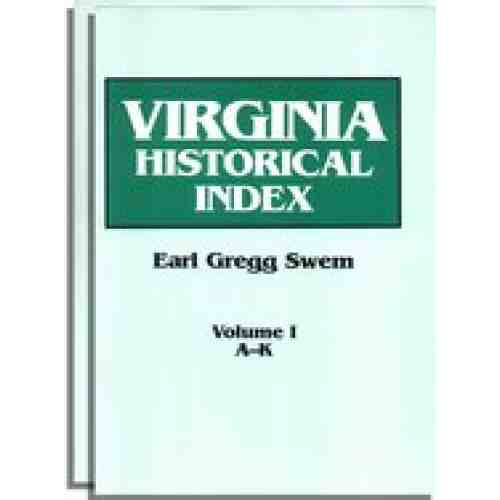This landmark work, first published by the Virginia Historical Society in two volumes in 1934 and 1936, is an index to all information relating to Virginia and Virginians in the seven most important serial publications devoted to Virginia genealogy and local history: The Virginia Magazine of History and Biography, William and Mary College Quarterly Historical Magazine, Tyler’s Quarterly Historical and Genealogical Magazine, Virginia Historical Register and Literary Advertiser, Lower Norfolk County Virginia Antiquary, Hening’s Statutes at Large, and Calendar of Virginia State Papers. Reflecting well over a hundred years’ worth of the best Virginia scholarship, and citing tens of thousands of individuals in hundreds upon hundreds of family histories, “Swem’s Index,” or “Swem,” as it is commonly called, is considered the most important publication in Virginia genealogy.
The periodicals indexed in Swem are prized today for their scholarly articles on genealogy and family history and were published under the editorship of the foremost authorities on Virginia genealogy, most notably Lyon Tyler and William Stanard. Entries in the index touch upon every phase of life in Virginia for more than three hundred years, with the majority of entries relating to the colonial period. Swem believed that “the later history of Virginia cannot be properly understood unless the colonial period is better known and is interpreted wisely as a result of the study of many printed documents.”
This emphasis on the colonial period, as well as the absolutely amazing comprehensiveness of the index, are what make Swem stand out from the crowd. Virtually every person who is documented in some way in colonial Virginia appears among the approximately one million entries in these volumes. Swem documents the details of colonial life by covering an exhaustive range of subjects, including place names, historical events, institutions, businesses, personal and family names, occupations, tools, censuses, Bibles, personal items, and just about any topic you can think of regarding any person, place, or thing in Virginia.
Genealogists will find thousands and thousands of family and individual names listed, as well as references to a wide range of subjects– such as Bible records, tithables, court cases, and college rosters–that may yield information pertaining to family history research. While the focus of this monumental work is on Virginia, there are references to individuals from many other states, including Kentucky, West Virginia, and Maryland. Another feature of interest to genealogists is the inclusion of words and phrases that are now obsolete, but were used in old wills and official documents.
Swem is invaluable not only to genealogists but to anyone interested in the complexities of daily life during the colonial period. In order to obtain some idea of the scope of the Index, one has only to look at the following small sampling of subjects: Animals; Arms; Army; Artists; Books; Bricks; Bridges; Building materials; Buildings; Cloth; Clothing; Counties; Courts; Drinks; Drugs and chemicals; Education; Ferries; Fords; Furnishings (household); Furniture; Horses; Houses; Indian; Iron; Land; Law; Manufactures; Ordinaries; Plants; Racing; Schools; Tools; Utensils (household); Warehouses. Under each heading are a number of subheadings. For example, under Arson are the following subheads: act concerning; British prisoners guilty of, in Hanover; case of; convicts practice; negro condemned for; negro convicted of; punishment for; reward for conviction of person committing; trial for, Buckingham County.
Despite the abundance of material covered, Swem is remarkably easy to use. All entries are referenced in the same way: volume number, abbreviation of publication title, and page number. Names of individuals are printed in full, with life dates, and profession and title, if known. Many cross references to subjects are included, making the index even more comprehensive. Those who have attempted genealogical research on the Internet will appreciate the ease of browsing through the index to study the subjects listed, instead of having to search online for each subject one at a time.
The most important local history resource, and perhaps the single most important Virginia resource, is Earl Gregg Swem, Virginia Historical Index . . . .This should be the first resource examined in any Virginia research project.–Ancestry’s Red Book
“Everyone who works on Virginia genealogy or history, especially in the colonial and early national periods, should use the Swem Index.”–Emily Croom
“Perhaps the most useful of the finding aids for researchers seeking information on early Virginia is E.G. Swem, editor, Virginia Historical Index.”–The Library of Virginia
Who Was Earl Gregg Swem?
Dr. Swem was a historian, bibliographer, and librarian. He served as chief of the Catalog Division at the Library of Congress until 1907, when he was named Virginia’s assistant state librarian. Twelve years later he joined the staff at the College of William and Mary, where he served as librarian until his retirement in 1944. Under his direction, the collection at William and Mary’s library grew from 25,000 books and 20,000 manuscripts to more than 240,000 books and about 400,000 manuscripts. Dr. Swem died in 1965, a year before the new Earl Gregg Swem Library at the College of William and Mary was completed.


